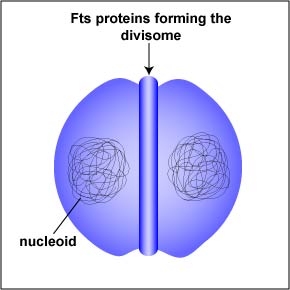Fig. 2: Bacterial Divisome
In general it is thought that during DNA replication (discussed in Unit 1), each strand of the replicating bacterial DNA attaches to proteins at what will become the cell division plane. For example, Par proteins function to separate bacterial chromosomes to opposite poles of the cell during cell division. They bind to the origin of replication of the DNA and physically pull or push the chromosomes apart, similar to the mitotic apparatus of eukaryotic cells.
In the center of the bacterium, a group of proteins called Fts (filamentous temperature sensitive) proteins interact to form a ring at the cell division plane. These proteins form the cell division apparatus known as the divisome and are directly involved in bacterial cell division by binary fission. The divisome is responsible for directing the synthesis of new cytoplasmic membrane and new peptidoglycan to form the division septum.

